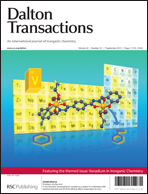Vanadium complexes having [VO]2+, [VO]3+ and [VO2]+ cores with hydrazones of 2,6-diformyl-4-methylphenol: synthesis, characterization, reactivity, and catalytic potential†
Abstract
The Schiff bases H3dfmp(L)2 obtained by the condensation of 2,6-diformyl-4-methylphenol and hydrazones [L = isonicotinoylhydrazide (inh), nicotinoylhydrazide (nah) and benzoylhydrazide (bhz)] are prepared and characterized. By reaction of [VIVO(acac)2] and the H3dfmp(L)2 in methanol the VIVO-complexes [VIVO{Hdfmp(inh)2}(H2O)] (1), [VIVO{Hdfmp(nah)2}(H2O)] (2) and [VIVO{Hdfmp(bhz)2}(H2O)] (3) were obtained. Upon their aerial oxidation in methanol [VVO(OMe)(MeOH){Hdfmp(inh)2}] (4), [VVO(OMe)(MeOH){Hdfmp(nah)2}] (5) and [VVO(OMe)(MeOH){Hdfmp(bhz)2}] (6) were isolated. In the presence of KOH, oxidation of 1–3 results in the formation of [VVO2{H2dfmp(inh)2}]n·5H2O (7), K[VVO2{Hdfmp(nah)2}] (8) and K[VVO2{Hdfmp(bhz)2}] (9). All compounds are characterized in the solid state and in solution, namely by spectroscopic techniques (IR, UV-Vis, EPR, 1H, 13C and 51V NMR), and DFT is also used to calculate the VIV hyperfine coupling constants of VIV-compounds and 51V NMR chemical shifts of several VV-species and assign them to those formed in solution. Single crystal X-ray analysis of [VVO(OMe)(MeOH){Hdfmp(bhz)2}] (6) and [VVO2{H2dfmp(inh)2}]n·5H2O (7) confirm the coordination of the ligand in the dianionic (ONO2−) enolate tautomeric form, one of the hydrazide moieties remaining non-coordinated. In the case of 7 the free N(pyridine) atom of the inh moiety coordinates to the other vanadium center yielding a polynuclear complex in the solid state. It is also demonstrated that the VVO2-complexes are catalyst precursors in the oxidative bromination of styrene by H2O2, therefore acting as functional models of vanadium dependent haloperoxidases. Plausible intermediates involved in the catalytic process are established by UV-Vis, 51V NMR and DFT studies.
![Graphical abstract: Vanadium complexes having [VO]2+, [VO]3+ and [VO2]+ cores with hydrazones of 2,6-diformyl-4-methylphenol: synthesis, characterization, reactivity, and catalytic potential](/en/Image/Get?imageInfo.ImageType=GA&imageInfo.ImageIdentifier.ManuscriptID=C3DT50469G&imageInfo.ImageIdentifier.Year=2013)
- This article is part of the themed collection: Vanadium in Inorganic Chemistry

 Please wait while we load your content...
Please wait while we load your content...